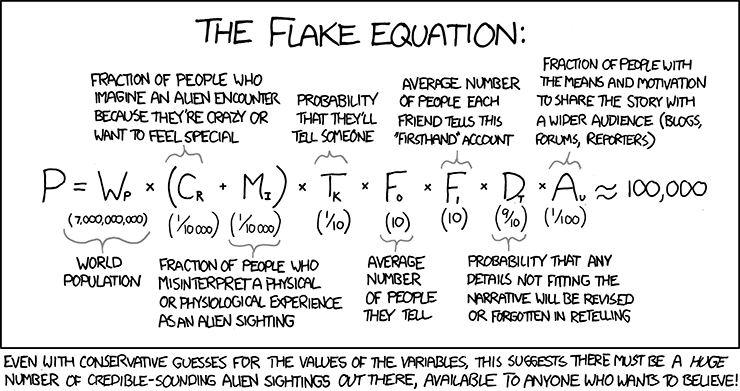Re: What makes the Earth habitable?
Posted: Sun Aug 01, 2010 2:42 pm
Chris Peterson wrote:The one thing I'm pretty confident of is that technological civilizations are very rare. We should observe them, otherwise, and I simply don't find any of the explanations that suggest they are present but somehow unseen to be convincing at all.
http://en.wikipedia.org/wiki/SETI#Fermi_paradox wrote:
<<Italian physicist Enrico Fermi suggested in the 1950s that if technologically advanced civilizations are common in the universe, then they should be detectable in one way or another. (According to those who were there, Fermi either asked "Where are they?" or "Where is everybody?")
The Fermi paradox can be stated more completely as follows:
The size and age of the universe incline us to believe that many technologically advanced civilizations must exist. However, this belief seems logically inconsistent with our lack of observational evidence to support it. Either
(1) the initial assumption is incorrect and technologically advanced intelligent life is much rarer than we believe, or
(2) our current observations are incomplete and we simply have not detected them yet, or
(3) our search methodologies are flawed and we are not searching for the correct indicators.
Possible explanations for the paradox suggest, for example, that while simple life may well be abundant in the universe, intelligent life may be exceedingly rare. In 2000, Peter Ward, professor of Biology and of Earth and Space Sciences at the University of Washington authored a book claiming the Rare Earth hypothesis. In short, the theory claims that the emergence of complex multicellular life (metazoa) on Earth required an extremely unlikely combination of astrophysical and geological events and circumstances. This hypothesis contradicts the principle of mediocrity, which SETI takes as an assumption.
Another suggestion, made by astrophysicist Ray Norris in 2000 (and subsequently by Allen Tough) was that gamma-ray burst events are sufficiently frequent to sterilize vast swaths of galactic real-estate. This idea was subsequently popularized by physicist Arnon Dar, and described in the show Death Star on PBS Nova.
Science writer Timothy Ferris has posited that since galactic societies are most likely only transitory, an obvious solution is an interstellar communications network, or a type of library consisting mostly of automated systems. They would store the cumulative knowledge of vanished civilizations and communicate that knowledge through the galaxy. Ferris calls this the "Interstellar Internet", with the various automated systems acting as network "servers".
If such an Interstellar Internet exists, the hypothesis states, communications between servers are mostly through narrow-band, highly directional radio or laser links. Intercepting such signals is, as discussed earlier, very difficult. However, the network could maintain some broadcast nodes in hopes of making contact with new civilizations.
Although somewhat dated in terms of "information culture" arguments, not to mention the obvious technological problems of a system that could work effectively for billions of years and requires multiple lifeforms agreeing on certain basics of communications technologies, this hypothesis is actually testable.
An alternate hypothesis is that evolutionary pressures in many environments favor species which rapidly consume available resources once they achieve dominance. By the time they have achieved sufficient technology to come to the notice of other civilizations, they are already well on their way to exhausting the resources of their host planet. Therefore the time period available for communication is finite, and very small compared with planetary timescales.>>
